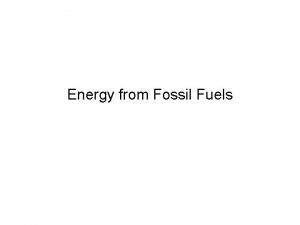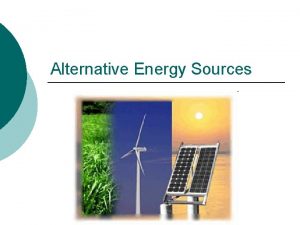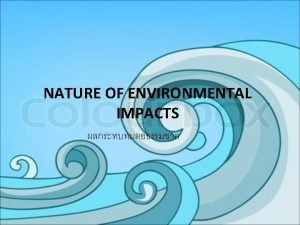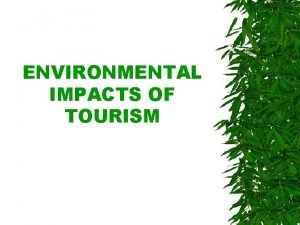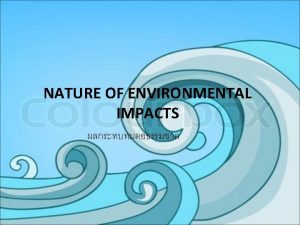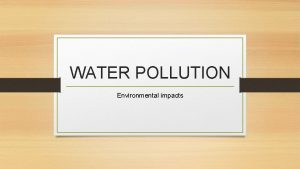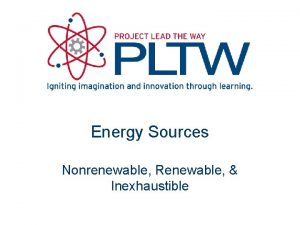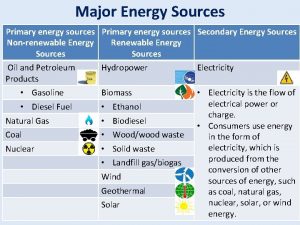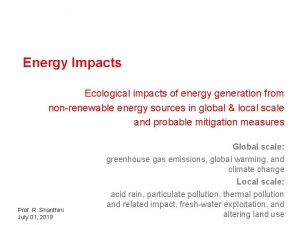Comparison of Environmental Impacts of Various Energy Sources









- Slides: 9

Comparison of Environmental Impacts of Various Energy Sources Melinda Marquis Colorado’s Changing Energy Portfolio November 14, 2015

Outline • Types of environmental impacts from energy production and use • Impacts from: • • Coal Natural gas (conventional) Natural gas (hydrofracturing) Wind Solar Hydropower Bioenergy Nuclear Photo by Satit Srihin. • Conclusions.

Types of Environmental Impacts • 1. Air • GHG emissions, acid rain, ozone, fine particulates, , SOx, NOx, Hg, etc. • 2. Water • Consumption and pollution • 3. Land • On-site and off-site • 4. Wildlife • 5. Human health • Direct effects, e. g. , increased risk of respiratory illness, increased risk of cancers

Impacts from Solar Power • 1. Air • Far fewer GHG emissions than from coal or other fossil fuels; no GHG from solar power generation, but some from manufacturing, materials transportation, installation, maintenance, and decommissioning, i. e. , lifecycle emissions • PV (0. 07 – 0. 18 pounds CO 2 eq. /k. Wh vs. 1. 4 – 3. 6 pounds CO 2 eq. /k. Wh for coal) • CSP (0. 08 – 0. 2 pounds CO 2 eq. /k. Wh vs. 1. 4 – 3. 6 pounds CO 2 eq. /k. Wh for coal) • 2. Water • PV panels do not use water in the production of electricity. • Like any manufacturing process, some water is used to produce the panels. • Thin film PV panels use rare-earth metals, which are mined in China, where sstronger regulations are needed to protect water and wildlife. • Concentrating solar power (CSP) with wet cooling requires large amounts of water, like othermal generators. • 3. Land • Solar power plants use large areas for collection of energy, and thus may interfere with existing land uses and can impact the use of areas such as wilderness or recreational management areas. • As energy systems may impact land through materials exploration, extraction, manufacturing and disposal, energy footprints can become incrementally high. • The construction of solar facilities on vast areas of land imposes clearing and grading, resulting in soil compaction, alteration of drainage channels and increased erosion. • 4. Wildlife • Habitat disruption and destruction • 5. Human Health • None.

• 1. Air Impacts from Wind Power • Far fewer GHG emissions than from coal or other fossil fuels; no GHG from solar power generation, but some from manufacturing, materials transportation, on-site construction and assembly, operation, maintenance, and decommissioning, i. e. , lifecycle emissions. • (0. 02 – 0. 04 pounds CO 2 eq. /k. Wh vs. 1. 4 – 3. 6 pounds CO 2 eq. /k. Wh for coal • 2. Water • Wind power requires no water in operation of turbines. Some water is used to manufacture steel and cement for turbines. The extremely small amount of water used in the lifecycle of producing wind power is considered a massive benefit. • Neodymium and dysprosium are used in turbine magnets. Most rare earth metals come from China, where environmental regulations are very weak compared to those in the U. S. ; mining can pollute air and water. • 3. Land • Uses large amounts of land, e. g. , 30 -141 acres per MW (cap. ); however, < one acre per MW is permanently disturbed and < 3. 5 acres per MW is temporarily disturbed during construction. Remainder of land can be sued for other purposes, e. g. , agriculture, livestock grazing, hiking trails. • 4. Wildlife • Bird and bats can be killed when colliding with turbine blades. • Habitat destruction can harm animals and ecosystems. • These impacts can be reduced, e. g. , by appropriate siting of plants, not operating turbines at very low wind speeds, when bats are most active. • 5. Human Health (Direct) • Some people do not like the sight or sound of spinning turbines. • 6. Possible temporary, local effects on weather • 7. No method yet to recycle metals in turbine blades Toxic waste at a Baotou, China, rare-earth metals processing plant. Rare-earth metals are not rare geographically, but difficult to extract economically.

Impacts from Hydropower Must distinguish between large, dammed reservoir hydro plants versus Run-of-the-River Plants with little to no water storage. • 1. Air • GHGs emitted during installation and dismantling of power plants. • If land is flooded to build a large reservoir, then the lifecyle emissions depend greatly on the size of the reservoir and the characteristics of the land that is flooded to build a reservoir. • Small, run-of-the-river plants emit 0. 01 to 0. 03 pounds CO 2 eq. per k. Wh (vs. 1. 4 – 3. 6 pounds CO 2 eq. /k. Wh for coal). • Large, dammed hydro plants in semi-arid areas emit ~0. 06 pounds CO 2 eq. per k. Wh. • When land is flooded, the vegetation and soil decomposes and release CO 2 and CH 4. The GHG emissions depend on site-specific qualities of the land. Tropical and peat land areas will release more GHGs • Large, dammed reservoir hydro plants emit ~ 0. 5 pounds CO 2 eq. per k. Wh (vs. 0. 6 to 2. 0 pounds CO 2 eq. /KWh for natural gas and Hoover Dam, on the Nevada-Arizona border, was built during the Depression. With a nameplate capacity of 2, 080 MW, it generates 4 billion kilowatt-hours of power per year for use in Nevada, Arizona, and California - enough to serve 1. 3 million people. From 1939 to 1949, Hoover was the world's largest hydroelectric plant. It is still one of the largest in the U. S. Chief Joseph Dam near Bridgeport, WA, is a major runof-the-river station without a large reservoir.

Impacts of Hydropower (continued) • 2. Water • Reservoir water is often more stagnant than normal, flowing water; therefore it has higher amounts of sediments and nutrients, which can cause too much algae and other weeds, which can in turn crowd out other flora and fauna. • Water in reservoirs evaporates more than water in flowing rivers. • Reservoir operators release water at certain times to prevent the downstream river level from becoming too low. If operators wait too long, downstream flora and fauna can be harmed and killed. Also, released water is lower in dissolved oxygen and heat thna river water, ad these differences can be harmful. Aeration can mitigate these impacts • 3. Land • The size of the reservoir created by the project varies widely. Plants in flat terrain require much more land than those in steep terrain where reservoirs can hold more water in a smaller space. • Flooding an area for a large dam can destroy forests, wildlife habitat, agricultural lands, recreational and scenic lands. • 4. Wildlife • Fish and other animals can be injured and killed by turbine blades. • 5. Human Health (Direct) Upon flooding a region, entire communities can be displaced.

Impacts of Bioenergy • 1. Air • GHG emissions ~ could be close to zero because growing plants recaptures the CO 2 released upon burning biomass; with CCS could be a net GHG sink. • Major cause of indoor pollution, making biomass burning (inside) a leading cause of child mortality. • Emissions generated during the feedstock production phase include vehicle emissions, diesel emissions from large equipment, emissions from storage/dispensing of fuels, and fugitive dust. • The level of emissions would vary with the scale of operations and may be greater for agricultural operations than forestry operations. • 2. Water • The use of pesticides and fertilizers to enhance feedstock (e. g. , corn) can also damage water quality. • 3. Land • Feedstock production is the cultivation of crops such as corn, soybeans, or grasses and the collection of crop residues and woody residues from forest. Growing feedstock can consume large amounts of land. • 4. Wildlife • Planting crops on pristine land, or cutting down or burning forests, destroys wildlife habitat. • 5. Human Health (Direct) • Growing plants for biofuels on using land, fertilizers and energy that could otherwise be used to grow food can lead to food shortages and increased prices for food. Municipal waste plant that processes garbage from Alexandria, Arlington, Va. , parts of the District of Columbia and Maryland. From Scientific American, August 26, 2011.

Conclusion • All energy sources have some environmental impact. • Types of impacts include: atmospheric (e. g. , GHG, air quality), water (withdrawal/consumption and pollution), land (e. g. , disturbance or pollution), wildlife damage (e. g. , kills by striking blade, poisoning, reduction of habitat), and direct human health (e. g. , black lung disease, heavy metal poisoning). • Some energy sources lead to far greater impacts than do others. • From worst to least: • Coal >> NG (unconv. ) > NG (conv. )> Nuclear* >Hydro >> Biopower > Solar > Wind • *Reasonable arguments can be made about the placement of nuclear in this list. The lack of a long-term storage plan and the potential for accidents, as well as for the spent fuel to be reprocessed into plutonium, which can be used to make bombs, are concerns.
 Tidal energy environmental impact
Tidal energy environmental impact Is petroleum a fossil fuel
Is petroleum a fossil fuel Positive effects of communication
Positive effects of communication Environmental impacts
Environmental impacts Print and web sources
Print and web sources Important of water management
Important of water management Direct comparison vs limit comparison
Direct comparison vs limit comparison Wireless health
Wireless health Energy energy transfer and general energy analysis
Energy energy transfer and general energy analysis Energy energy transfer and general energy analysis
Energy energy transfer and general energy analysis

